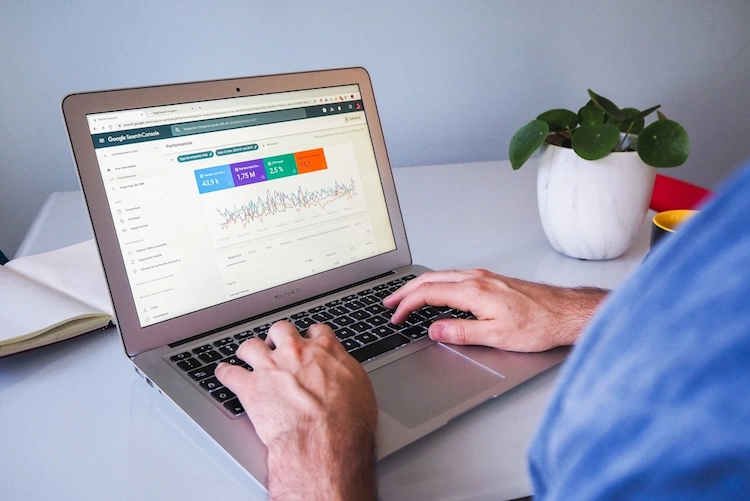Content marketing focuses on creating and distributing valuable, relevant, and consistent content to attract and retain a clearly defined audience — and it’s taking the marketing world by storm.
Businesses of all sizes are leveraging content marketing to establish their brand authority, engage with customers, and differentiate themselves from competitors. The bad news is, in such a crowded landscape, it’s easy to be drowned out. Furthermore, it can sometimes feel like you’re shooting in the dark unless you know how to measure success.
So, how do you know if your content marketing is working?

1. Set clear objectives & KPIs.
Setting clear objectives and Key Performance Indicators (KPIs) is the cornerstone of effective content marketing. Aligning your content strategy with overarching business objectives — brand awareness, lead generation, direct sales, or something else — ensures that every piece of content serves a purpose. You always want to avoid posting for the sake of it; that’s a lot of work for you, and your audience won’t get anything out of it.
When it comes to content marketing at Catalyst, we ensure each blog post, video, infographic, or social media update works towards a specific goal that contributes to the broader success of your business. Marketing goals are derived from your unique brand strategy because we know linking content efforts directly to business outcomes makes a huge difference.The “right” KPIs look different for every business, but they should always directly reflect your goals. For example:
KPIs for attracting new audiences,
Relevant KPIs might include the number of ranking keywords, website visitors, lead magnet downloads, newsletter subscriptions, and social media followers. The bottom line here is whether the content is effectively increasing the number of marketing qualified leads in your pipeline.
KPIs for nurturing leads.
The focus here shifts towards engagement metrics like likes, comments, shares, LinkedIn company page views, and marketing email reply rates. However, the more telling KPIs in this stage are whether your sales cycle is shortening and if your conversion rate is on the rise.
KPIs for selling.
The effectiveness of case studies and videos can be gauged through improved conversion rates, indicating that your content is successfully driving sales.
KPIs for catalysing referrals.
When you delight existing customers, you can expect an increase in the number of organic referrals. This becomes a pivotal KPI, showing that your value-adding content is encouraging customers to spread the word about your brand.

2. Choose the right tools for measuring success.
Like the “right” KPIs, the “right” tools depend on your goals. At Catalyst, we use and recommend a variety of tools to measure success, but we don’t make you use a toolbox that doesn’t work for you. Instead, we select software that’ll integrate seamlessly with each other and align with your strategic goals.
Here are the tools we commonly mix and match, depending on our client’s needs and goals.
- Google Analytics stands out for tracking website traffic, user behaviour, and conversion metrics, providing a comprehensive view of how content impacts your online presence.
- SEO tools for understanding how well your content performs in search engine rankings, identifying opportunities for optimisation, and tracking keyword performance.
- Social media analytics, available through platforms’ native tools or third-party applications, offer a deep dive into engagement metrics, helping to gauge the effectiveness of content in nurturing leads and engaging with your audience.
- Content Management Systems (CMS’s) for publishing and managing content as well as built-in analytics that offer insights into content performance, visitor interactions, and more.
- A unified CRM serves as the single source of truth. This integration ensures that all insights feed into a central digital location, facilitating a holistic view of the customer journey and contents’ role within it.

3. Interpret the data & analyse content performance.
Once the data starts coming in, it’s time to unpack it — and what the results mean for your business.
Analysing your content’s performance requires a multi-faceted approach that considers the breadth of your content’s impact and the depth of engagement it generates. In doing so, you can refine your content strategy to better meet your audience’s needs and drive your business objectives forward.It’s important to consider a balance between quantitative and qualitative measures. Sometimes quantity is better than quality (like when you’re striving for high reach as a KPI in a digital advertising campaign), but usually the reverse is true; qualitative data matters more (like the number of leads converting to sales).
Key metrics to consider.
What you analyse depends on your marketing initiatives and goals, but these are some of the metrics we commonly review.
- Traffic: Measure website traffic to assess visibility and content appeal. Track the source of traffic — search engines, social media, or direct visits — and analyse user behaviour, including visited pages and bounce rates, to understand how well (or poorly) your content engages your audience.
- Engagement: Evaluate content interactions by reviewing likes, shares, comments, popular times of day for engagement, and time spent on a piece of content. High engagement rates indicate content quality and relevance.
- Lead generation & conversion: Determine content’s role in generating leads and converting visitors by tracking lead origins and conversion rates. CRM integration can highlight the most effective content for advancing prospects through the sales funnel.
- SEO: Track ranking changes, keyword effectiveness, and organic search traffic. This provides insights into content optimisation for search engines and its impact on visibility.
- Reach: Analyse social media reach to gauge how extensively your content is shared beyond your direct followers. Engagement metrics on social platforms can reveal content’s success in sparking conversations and enhancing brand awareness.
No more “analysis paralysis”.
Despite the abundance of tools and data available, we always avoid the dreaded “analysis paralysis”. Perhaps you’ve experienced it before with a previous agency — you’re handed so much indecipherable, jargon-packed data that your insights become meaningless and you can’t drive purposeful actions.
We never lose sight of what truly matters and always come back to those foundation goals we set at the start. Is your business attracting new leads? Is your sales cycle shortening? Are you seeing more sales and referrals? Questions like these ensure our focus stays on achieving tangible business outcomes rather than getting lost in endless data analysis (and confusing you in the process).

4. Take action.
After analysing your content’s performance, it’s time to use those insights to make informed decisions, refine your strategy, and get the phone ringing (literally or metaphorically).
Identify patterns & trends.
Look for recurring themes in your data. Are certain types of content consistently performing well? Do specific topics or formats resonate more with your audience? Perhaps you’ve noticed website visitors from a geographic area you didn’t expect, or that video content engages your audience three times as much as text-only posts.
Use these patterns to guide your content creation and optimisation strategies.
Adjust & refine.
Content marketing is not set-it-and-forget. Be prepared to make regular adjustments based on what your data is telling you. This ensures your content strategy remains effective and responsive to your audience’s evolving needs.
Capitalise on what works, improve or lose what doesn’t. This could involve focusing more on the content formats that drive engagement, tweaking your posting schedule based on user activity times, swapping Facebook for LinkedIn, or adjusting your content topics to better match audience interests.
Experiment & test the waters.
Digital strategies, technology, and platforms are constantly evolving, so don’t be afraid to experiment with new content forms, channels, or strategies. See what works and refine your approach based on the outcomes. This iterative process of testing, learning, and adjusting is key to finding what resonates most with your audience and maximises your content’s impact.
Stop wasting time by “winging it”.
Understanding the impact of your content marketing efforts is crucial in shaping a strategy that resonates with your audience, contributes to business goals, and drives profitable results.
So, is your content marketing working? Let’s explore how you can optimise your content to achieve better engagement, generate more leads, and enhance your ROI. Book a free 15-minute consult call and take the first step towards transforming your content marketing efforts.



